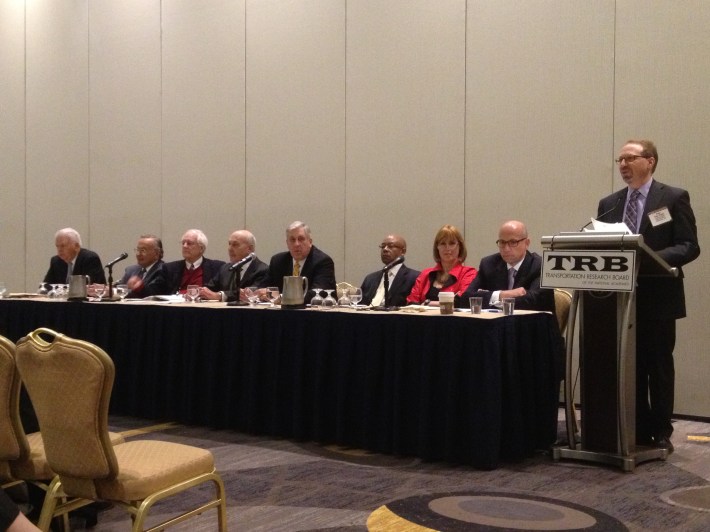
“Highway people like highways, transit people like transit, rail people like rail,” Transportation Secretary Anthony Foxx said yesterday at the annual meeting of the Transportation Research Board. “But our transportation system should be greater than the sum of its parts.”
Foxx wasn’t the first to lament the atomization of the various modes at the federal level. Just this morning, in a hearing before the Senate Banking Committee, Federal Transit Administrator Peter Rogoff touted the agency’s efforts at “tearing away federal stovepipes" but said "coordination is still a problem at the federal level."
Rogoff knows better than anyone that to some degree, those stovepipes are necessary -- and that if they’re torn away completely, transit has the most to lose.
After all, just yesterday Rogoff moderated a panel at TRB comprised of eight of his predecessors at the FTA (and its precursor, the Urban Mass Transit Administration). And he asked them whether it made sense to consolidate the modal agencies -- presumably not just highways, transit and rail but also aviation, pipelines, the St. Lawrence Seaway, and others.
“Is it time to do away with modal silos?” Rogoff asked.
“Every administration kicks around the idea of combining everything into one agency,” admitted Brian Clymer, who presided over the agency from 1989 to 1993.
The Department of Transportation has only been one, unified agency since 1967, when the various pre-existing modal agencies were brought under one roof. Before that, some were housed under separate cabinet departments like Commerce or Agriculture.
Maintaining separate agencies under one department is probably as much unity as is called for, the former administrators agreed. First of all, whenever you have such technical knowledge, “you’re always going to have some degree of specialization,” Clymer said -- and there’s nothing wrong with that. The people who know the sweet spot for streetcar headways aren't necessarily the foremost experts on warm-mix asphalt. But that doesn't mean they can’t talk to each other -- and it certainly doesn’t mean that planning should happen in isolation.
After all, as Jim Simpson (2006-2008) noted, the best way to cut down on airline delays and congestion is to improve Amtrak service. But is that the solution that jumps to the minds of people at the Federal Aviation Administration? Probably not -- but that's a reason to strengthen communication among the different agencies, not eliminate them.
After all, the former transit administrators feared -- with reason -- that transit would get swallowed up in a merger like that. “By moving smaller agencies into one, is the effect that you get just subsuming the advocate for transit or for rail into a highway organization?” asked Clymer. “You’re basically downgrading their advocates. I don’t think I ever saw the wisdom in that.”
That point was echoed by Al DelliBovi (1987–89), who argued, “The transit program needs its own identity.” The highway agency, he said, “was like a paramilitary organization -- they were all about pouring concrete, and they didn’t want to hear about buses and trains.”
DelliBovi noted that although it was wise to take the word “urban” out of the agency name, FTA retains a focus on local needs that is different from the mindset of the highway people. “It’s better served by its own program,” he concluded.
There are other considerations, said Gordon Linton (1993-1999). He suggested that maybe Congress’s committee structure was more of a problem than the modal separation at U.S. DOT. He said it’s hard for lawmakers to agree to “lose that authority and control” and “play good in the sandbox.” Within DOT, he said, planning has become much more integrated, and dialogue continues among the modes, and for now, anything more would be “a lot of wasted effort.”
Jenna Dorn (2001-2006) couldn’t agree more. “Never reorganize,” she counseled. Everyone always talks about it, but “it’s rarely a good idea, and it’s so hard to execute.”





